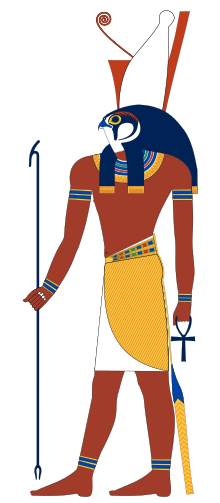Kemetism
The kemetism , also Egyptian paganism or Egyptian neo-paganism , is a contemporary effort to revive a pre-Christian indigenous " natural religion ", referring to culture, mythology and religious beliefs of the ancient Egyptians . The movement has the most supporters in the United States , France and the Czech Republic .
history
Kemetism appeared, along with the other neo-Pagans, in the 1970s in the United States. The Church of the Eternal Source was founded in 1970, the Ausar Auset Society in 1973 and the Kemetic Orthodoxy in the 1980s . In the 2000s, Kemetism also spread outside of the United States.
Currents
There are three main currents of Kemetism: the traditional "orthodox" Kemetism, the "black ( Afrocentric ) Kemetism" and the "Neo-Kemetism".
Deities
All Egyptian gods are worshiped in Kemetism . The most important are:
- Re / Ra : Sun god, is seen as the most important god, since life is only possible through him. He has the head of a hawk.
- Horus : main god, mostly carries a what scepter and ankh . He has the head of a hawk.
- Anubis : god of the rites of the dead. He has the head of a jackal.
- Osiris : god of the hereafter. He has a human head.
- Thoth : God of the moon, magic, science, scribes, wisdom and the calendar. He has the head of an ibis.
- Isis : goddess of birth, rebirth and magic , but also goddess of the dead.
Individual evidence
- Marilyn C. Krogh; Brooke Ashley Pillifant, Kemetic Orthodoxy: Ancient Egyptian Religion on the Internet: A Research Note , Sociology of Religion (2004).
- Ellen Cannon Reed, Circle of Isis: Ancient Egyptian Magic for Modern Witches (2002), ISBN 978-1-56414-568-0 .
- JG Melton, Encyclopedia of American Religions , 5th ed., Detroit (1996).

